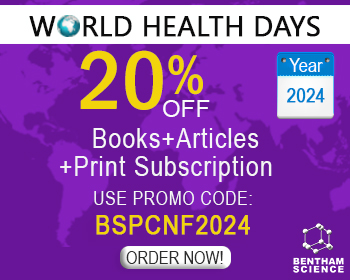Abstract
Parkinson’s disease is one of the most common adult-onset, a chronic disorder involving neurodegeneration, which progressively leads to deprivation of dopaminergic neurons in substantia nigra, causing a subsequent reduction of dopamine levels in the striatum resulting in tremor, myotonia, and dyskinesia. Genetics and environmental factors are believed to be responsible for the onset of Parkinson’s disease. The exact pathogenesis of Parkinson's disease is quite complicated and the present anti-Parkinson's disease treatments appear to be clinically insufficient. Comprehensive researches have demonstrated the use of natural products such as ginseng, curcumin, ashwagandha, baicalein, etc. for the symptomatic treatment of this disease. The neuroprotective effects exhibited by these natural products are mainly due to their ability to increase dopamine levels in the striatum, manage oxidative stress, mitochondrial dysfunction, glutathione levels, clear the aggregation of α- synuclein, induce autophagy and decrease the pro-inflammatory cytokines and lipid peroxidation. This paper reviews various natural product studies conducted by scientists to establish the role of natural products (both metabolite extracts as well as pure metabolites) as adjunctive neuroprotective agents.
Keywords: Parkinson's Disease, Dopamine, Natural Products, Herbal Medicines, Natural Neuroprotective Agents, Neurodegeneration.
[http://dx.doi.org/10.1016/S1474-4422(06)70471-9] [PMID: 16713924]
[http://dx.doi.org/10.1007/s11064-013-1005-4] [PMID: 23430469]
[http://dx.doi.org/10.1111/cbdd.12127] [PMID: 23461900]
[http://dx.doi.org/10.5142/jgr.2012.36.4.342] [PMID: 23717136]
[http://dx.doi.org/10.1016/j.jgr.2017.03.011] [PMID: 29989012]
[http://dx.doi.org/10.1016/j.expneurol.2003.08.002] [PMID: 14637121]
[http://dx.doi.org/10.1016/j.jep.2011.02.017] [PMID: 21349320]
[http://dx.doi.org/10.1016/j.neulet.2009.02.044] [PMID: 19429045]
[http://dx.doi.org/10.1248/bpb.b14-00022] [PMID: 24882401]
[http://dx.doi.org/10.1016/j.jep.2009.08.003] [PMID: 19666100]
[http://dx.doi.org/10.2478/s11658-007-0015-0] [PMID: 17415533]
[http://dx.doi.org/10.1111/j.1471-4159.2005.03000.x] [PMID: 15773909]
[http://dx.doi.org/10.1016/j.nut.2012.03.007] [PMID: 22817828]
[http://dx.doi.org/10.1002/ptr.814] [PMID: 11507743]
[http://dx.doi.org/10.1111/j.1460-9568.2008.06314.x] [PMID: 18662333]
[http://dx.doi.org/10.1002/ptr.1486] [PMID: 15472919]
[http://dx.doi.org/10.1016/j.tiv.2007.02.004] [PMID: 17509817]
[http://dx.doi.org/10.1007/BF02859941] [PMID: 12973934]
[http://dx.doi.org/10.1016/j.jep.2010.12.030] [PMID: 21195155]
[http://dx.doi.org/10.1155/2017/8429290] [PMID: 28835767]
[http://dx.doi.org/10.1007/s11064-008-9749-y] [PMID: 18512151]
[http://dx.doi.org/10.1089/jmf.2009.1252] [PMID: 20521982]
[http://dx.doi.org/10.3390/metabo9110244] [PMID: 31652802]
[http://dx.doi.org/10.1017/S0007114510000218] [PMID: 20187987]
[http://dx.doi.org/10.1007/s10571-010-9502-3] [PMID: 20563702]
[http://dx.doi.org/10.1016/j.jep.2010.05.006] [PMID: 20470875]
[http://dx.doi.org/10.1016/j.fct.2010.05.002] [PMID: 20457209]
[http://dx.doi.org/10.3390/nu11071671] [PMID: 31330885]
[http://dx.doi.org/10.1007/s11064-019-02835-z] [PMID: 31309393]
[http://dx.doi.org/10.3390/molecules24112182] [PMID: 31185705]
[http://dx.doi.org/10.1016/j.toxrep.2019.07.012] [PMID: 31440456]
[http://dx.doi.org/10.9734/EJMP/2016/26453] [PMID: 27341283]
[http://dx.doi.org/10.1016/j.jep.2019.112226] [PMID: 31574343]
[http://dx.doi.org/10.1039/C9FO02288K] [PMID: 31971191]
[http://dx.doi.org/10.1016/j.neuint.2008.10.003] [PMID: 19000728]
[http://dx.doi.org/10.1111/j.1745-7254.2005.00019.x] [PMID: 15659115]
[http://dx.doi.org/10.1016/j.neuropharm.2015.10.024] [PMID: 26525190]
[http://dx.doi.org/10.3390/ijms160714395] [PMID: 26114390]
[http://dx.doi.org/10.1080/10286020410001690172] [PMID: 15621629]
[http://dx.doi.org/10.1016/j.ejcb.2005.07.003] [PMID: 16323286]
[http://dx.doi.org/10.1016/j.neulet.2008.05.116] [PMID: 18586394]
[http://dx.doi.org/10.1016/j.pbb.2011.01.011] [PMID: 21262257]
[http://dx.doi.org/10.1016/j.chroma.2008.03.059] [PMID: 18407279]
[http://dx.doi.org/10.3390/molecules24101937] [PMID: 31137493]
[http://dx.doi.org/10.1038/aps.2010.77] [PMID: 20644549]
[http://dx.doi.org/10.1016/j.jep.2018.05.014] [PMID: 29772356]
[http://dx.doi.org/10.3390/molecules191117763] [PMID: 25421414]
[http://dx.doi.org/10.2174/138161212798918995] [PMID: 22211691]
[http://dx.doi.org/10.1080/10715760500233113] [PMID: 16298737]
[http://dx.doi.org/10.1007/s12264-012-1238-2] [PMID: 22622825]
[http://dx.doi.org/10.1007/s12035-016-9843-0] [PMID: 27003823]
[http://dx.doi.org/10.1016/j.freeradbiomed.2007.11.011] [PMID: 18166164]
[http://dx.doi.org/10.2174/1389201019666181008112244] [PMID: 30295188]
[http://dx.doi.org/10.1093/aje/kwm338] [PMID: 18156141]
[http://dx.doi.org/10.1016/j.jnutbio.2004.05.002] [PMID: 15350981]
[http://dx.doi.org/10.2165/00002512-200320100-00001] [PMID: 12875608]
[http://dx.doi.org/10.1016/j.lfs.2005.12.006] [PMID: 16445946]
[http://dx.doi.org/10.1179/135100002125000424] [PMID: 12189048]
[http://dx.doi.org/10.1046/j.1471-4159.2001.00490.x] [PMID: 11553681]
[http://dx.doi.org/10.4103/pm.pm_477_16] [PMID: 29200710]
[http://dx.doi.org/10.1080/14786419.2018.1434649] [PMID: 29397771]
[http://dx.doi.org/10.1016/j.neuint.2015.01.003] [PMID: 25747493]
[http://dx.doi.org/10.1080/14786419.2019.1577839] [PMID: 30821512]
[http://dx.doi.org/10.1016/j.foodchem.2018.08.045] [PMID: 30309531]
[http://dx.doi.org/10.1016/j.jns.2011.02.025] [PMID: 21376343]
[http://dx.doi.org/10.1038/s41598-020-62603-w] [PMID: 32221407]
[http://dx.doi.org/10.1002/jssc.201901287] [PMID: 32003117]
[http://dx.doi.org/10.1002/ptr.2708] [PMID: 19089849]
[http://dx.doi.org/10.1055/s-2006-959619] [PMID: 17230346]
[http://dx.doi.org/10.1016/j.jnutbio.2010.08.005] [PMID: 21190833]
[http://dx.doi.org/10.1097/01.wnr.0000239951.14954.10] [PMID: 17047462]
[http://dx.doi.org/10.1211/jpp.61.12.0015] [PMID: 19958593]
[http://dx.doi.org/10.1007/s12031-011-9693-1] [PMID: 22205146]
[http://dx.doi.org/10.1016/j.tiv.2020.104823] [PMID: 32147576]
[http://dx.doi.org/10.1007/s12031-009-9182-y] [PMID: 19219567]
[http://dx.doi.org/10.1016/j.jep.2019.112208] [PMID: 31476443]
[http://dx.doi.org/10.1016/j.jep.2019.112081] [PMID: 31319121]
[http://dx.doi.org/10.3390/molecules16075349] [PMID: 21705974]
[http://dx.doi.org/10.3390/molecules24224021] [PMID: 31698834]
[http://dx.doi.org/10.1007/s12640-019-00048-4] [PMID: 31055769]
[http://dx.doi.org/10.1007/s11033-020-05394-7] [PMID: 32239464]
[http://dx.doi.org/10.1016/j.bbabio.2020.148157] [PMID: 31987812]
[http://dx.doi.org/10.1007/s00705-018-3842-6] [PMID: 29633078]
[http://dx.doi.org/10.1016/j.neuint.2020.104671] [PMID: 31926197]
[http://dx.doi.org/10.3233/JAD-190870] [PMID: 31658061]
[http://dx.doi.org/10.1007/s11356-019-04139-9] [PMID: 30648235]
[http://dx.doi.org/10.1080/14786419.2018.1488711] [PMID: 30362366]
[http://dx.doi.org/10.3390/molecules24244489] [PMID: 31817934]
[http://dx.doi.org/10.1016/j.fct.2019.110765] [PMID: 31430510]
[http://dx.doi.org/10.4062/biomolther.2018.234] [PMID: 30739428]
[http://dx.doi.org/10.1016/j.jep.2019.02.023] [PMID: 30769041]
[http://dx.doi.org/10.3390/ijms20030491] [PMID: 30678325]
[http://dx.doi.org/10.3390/antiox8100492] [PMID: 31627372]
[http://dx.doi.org/10.1007/s11033-019-04786-8] [PMID: 30945069]
[http://dx.doi.org/10.1021/acs.jafc.9b00922] [PMID: 30900456]
[http://dx.doi.org/10.1002/pca.2606] [PMID: 26751603]
[http://dx.doi.org/10.1007/BF02907158]
[http://dx.doi.org/10.1016/j.exger.2019.02.016] [PMID: 30825547]
[http://dx.doi.org/10.3126/jist.v20i1.13916]
[http://dx.doi.org/10.1055/s-2007-969447]
[http://dx.doi.org/10.3390/molecules24040810] [PMID: 30813423]
[http://dx.doi.org/10.1021/np50039a027]
[http://dx.doi.org/10.3389/fncel.2019.00018] [PMID: 30804756]
[http://dx.doi.org/10.1007/BF02860184]
[http://dx.doi.org/10.1023/A:1006485726523] [PMID: 11334151]
[http://dx.doi.org/10.1007/s12565-019-00486-2] [PMID: 30949912]
[http://dx.doi.org/10.1016/S0006-2952(00)00264-1] [PMID: 10751547]
[http://dx.doi.org/10.1016/0304-4165(91)90013-7] [PMID: 1659912]
[http://dx.doi.org/10.1016/j.phymed.2019.152833] [PMID: 30903943]
[http://dx.doi.org/10.1055/s-0033-1350674] [PMID: 23925903]
[http://dx.doi.org/10.1021/acs.jafc.9b00133] [PMID: 30995031]
[http://dx.doi.org/10.1016/j.toxrep.2019.06.014] [PMID: 31334034]
[http://dx.doi.org/10.1186/s12974-019-1472-x] [PMID: 31010422]
[http://dx.doi.org/10.1016/j.phymed.2009.08.007] [PMID: 19747809]
[http://dx.doi.org/10.1055/s-2006-959362] [PMID: 8824946]
[http://dx.doi.org/10.3389/fimmu.2019.00936] [PMID: 31118933]
[http://dx.doi.org/10.1016/j.jep.2008.02.015] [PMID: 18372132]
[http://dx.doi.org/10.1016/j.cbi.2017.12.007] [PMID: 29223569]
[http://dx.doi.org/10.1016/j.phymed.2019.152842] [PMID: 31048127]
[http://dx.doi.org/10.1016/j.lfs.2019.116600] [PMID: 31251998]
[http://dx.doi.org/10.1155/2019/6527638] [PMID: 31182996]
[http://dx.doi.org/10.1016/j.mcn.2019.103416] [PMID: 31654699]
[http://dx.doi.org/10.1111/jnc.14868] [PMID: 31520529]
[http://dx.doi.org/10.1016/S0021-9673(01)01232-8] [PMID: 11695872]
[http://dx.doi.org/10.2174/1874847300902010001]
[http://dx.doi.org/10.1016/j.bioorg.2019.103278] [PMID: 31541802]
[http://dx.doi.org/10.1007/s12017-019-08562-6] [PMID: 31401719]
[http://dx.doi.org/10.1016/j.jep.2019.112213] [PMID: 31562951]
[http://dx.doi.org/10.1016/j.nut.2019.04.006] [PMID: 31586482]
[http://dx.doi.org/10.1016/j.neulet.2019.134652] [PMID: 31778768]
[http://dx.doi.org/10.1007/s10787-008-8039-2] [PMID: 19127347]
[http://dx.doi.org/10.1016/j.ecoenv.2019.110065] [PMID: 31869719]
[http://dx.doi.org/10.1021/acs.jafc.0c00007] [PMID: 32011134]
[http://dx.doi.org/10.1016/j.gpb.2018.10.007] [PMID: 31786313]
[http://dx.doi.org/10.2174/1568026619666191025154834] [PMID: 31654510]
[http://dx.doi.org/10.1093/jaoac/102.5.1378] [PMID: 31200787]
[http://dx.doi.org/10.1093/jaoac/102.5.1407] [PMID: 31200784]
[http://dx.doi.org/10.2174/1389203720666190502154129] [PMID: 31057098]
[http://dx.doi.org/10.2174/1568026619666181224111319] [PMID: 30582479]
[http://dx.doi.org/10.4103/0973-1296.172956] [PMID: 27013789]
[http://dx.doi.org/10.1159/000085382] [PMID: 15956811]
[http://dx.doi.org/10.2174/187152711794480483] [PMID: 20874702]




























